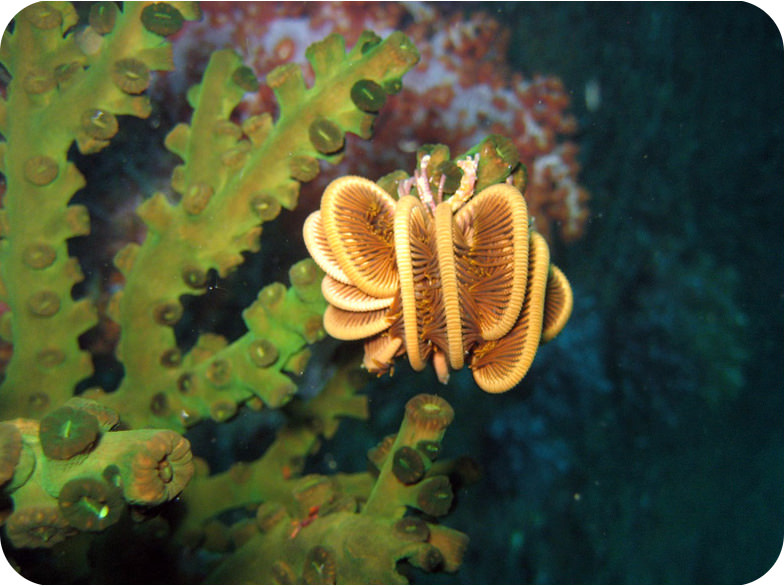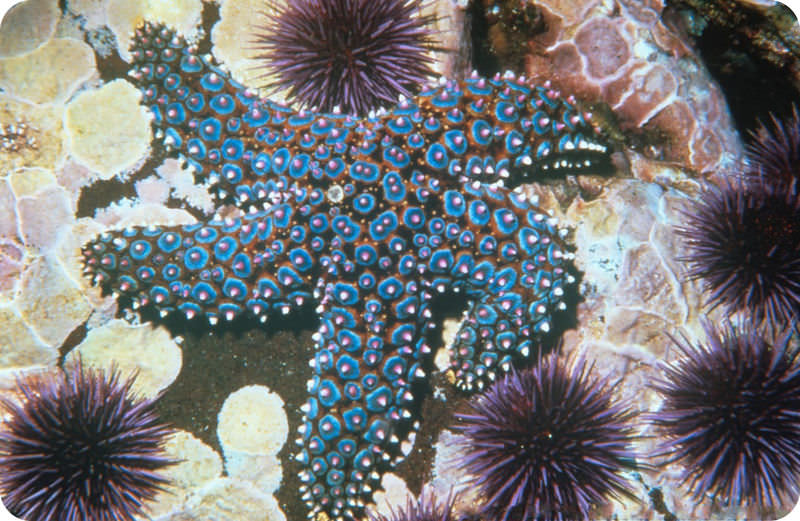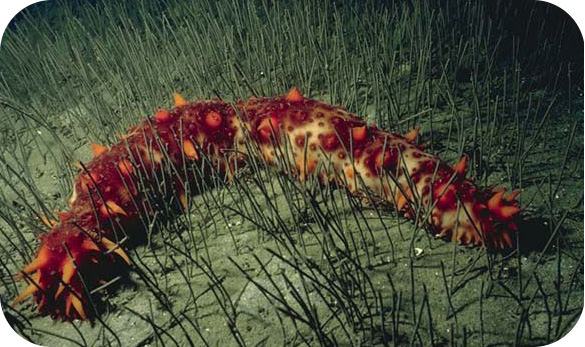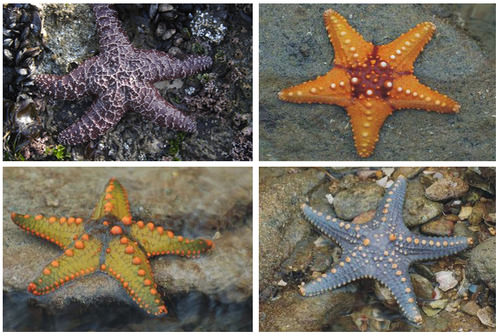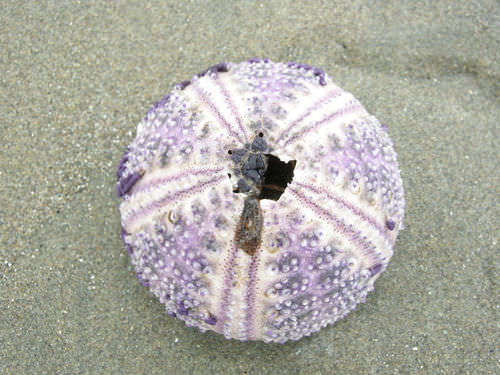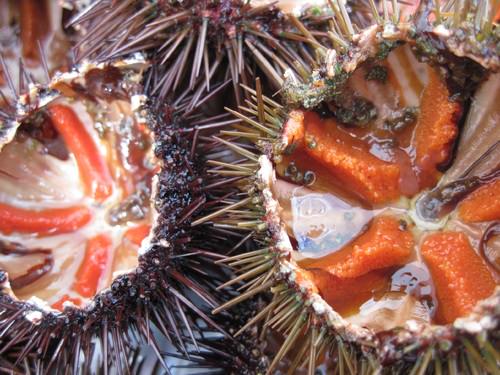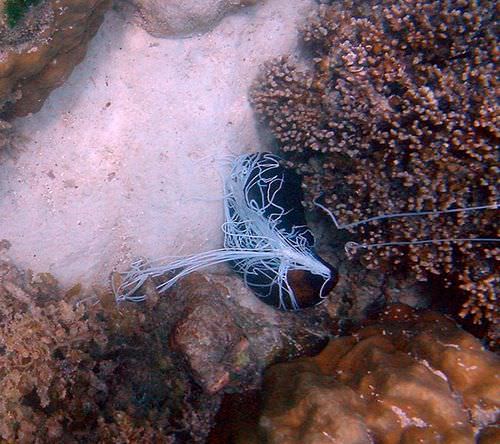15.44 Echinoderm 分类 -- -- 高级
章节大纲
-
This is obviously a sea cucumber. So classifying can't be that difficult, can it?
::这显然是一个海参 所以分类不会那么难吧?Actually, it is not. Sea cucumbers are with leathery skin and an elongated body containing a single branched gonad . Sea cucumbers are found on the sea floor worldwide. These are quite different from the other echinoderms. In fact, all echinoderms easily fall into one of five classes.
::事实上,它不是。海参的皮肤是皮质的皮质,长的体形是单一的枝条。海参在全世界的海底都有。它们与其他的海参大不相同。事实上,所有海参都很容易掉入五类中的一类。Classification of Echinoderms
::杂类物质分类Unlike , echinoderm is not currently undergoing any drastic changes, and essentially all existing fall into five clearly defined classes. Classifications that include all of the species are somewhat more complex and can include 25 different classes. The five classes of existing echinoderms are these:
::与目前不同的是,电子电离层目前没有发生任何急剧的变化,基本上所有现有的都分为五个明确界定的类别。 包括所有物种的分类比较复杂,可以包括25个不同类别。-
Crinoidea.
::克里诺迪亚 -
Asteroidea.
::阿斯捷洛狄亚州 -
Ophiuroidea.
::奥菲罗蒂亚 -
Echinoidea.
::乙基尼西蒂亚 -
Holothuroidea.
::万神殿 万神殿 万神殿 万神殿 万神殿 万神殿 万神殿 万神殿 万神殿 万神殿 万神殿 万神殿 万神殿 万神殿 万神殿 万神殿 万神殿 万神殿 万神殿 万神殿 万神殿 万神殿 万神殿 万神殿 万神殿 万神殿 万神殿 万神殿 万神殿
Echinoderm species are generally classified into each of these groups based on their body forms and organization. Differences between the classes can also be found in various features of the endoskeleton and the organ systems . In this section we will consider the similarities and differences between each of these groups.
::此类物种一般根据其身体形态和组织,被归入其中每一类,在内骨骼和器官系统的不同特征中也可发现不同类别之间的差别,在本节中,我们将考虑其中每一类之间的异同。Organisms in each of the five classes are described in Table .
::5个班级中每个班级的生物在表12中都有说明。Class (includes) Description Example Crinoidea
::白硅酸酯-
Feathers
stars
::羽毛星星 -
Sea lilies
::海百合
Fewer than 100 species exist. Many have more than five arms. They are the earliest and most primitive echinoderms. They live on the ocean floor in mainly deep and are filter feeders . feather star
::羽羽羽星星Asteroidea
::阿斯色化物-
Sea stars
::海星
Almost 2,000 species exist. Most have five arms. Many are brightly colored. They live on the ocean floor in mainly shallow water and are predators or scavengers . sea star
::海洋恒星Ophiuroidea
::欧花亚acolor-
Brittle stars
::微粒恒星
About 2,000 species exist. The central disk is distinct from the arms. They move by flapping their arms, which lack suckers. They live on the ocean floor in shallow or deep water and are predators, scavengers, deposit feeders , or filter feeders. brittle star
::核颗粒星Echinoidea
::乙酰胆碱酯-
Sea urchins
::海胆 -
Sand dollars
::沙沙美元 -
Sea biscuits
::海饼干 -
Heart urchins
::心脏胆
About 100 species exist. They do not have arms but do have tube feet . They have a specialized mouth part with teeth to scrape food from rocks. They live on the ocean floor in shallow or deep water and are predators, herbivores , or filter feeders. sea urchin
::海胆Holothuroidea
::全光极亚-
Sea cucumbers
::海黄瓜
About 1,000 species exist. They have long bodies without arms. Unlike other echinoderms, they have a . They live on the ocean floor in shallow or deep water and are deposit feeders or filter feeders. sea cucumber
::黄瓜Crinoidea
::白硅酸酯The crinoids , such as the sea lilies and feather stars, are considered to be the most primitive of the echinoderm species. They have five-fold radial symmetry , but they often have more than five arms. There are about 80 crinoid species, and many of them live in deep regions of the ocean, so they tend to be less familiar than echinoderms that are commonly found in shallow coastal regions. Although there are only a few species around today, crinoids make up a large fraction of the echinoderm . They were dominant in the (540 - 250 million years ago) but experienced an almost complete extinction at the end of the Permian period (250 million years ago). An example of a feather star is shown in Figure .
::骨质动物,如海百合和羽状恒星,被认为是最原始的脑电离层物种。它们有五倍的线性对称,但通常有五臂以上。大约有80个骨质物种,其中许多生活在海洋深处,因此它们往往比浅浅沿海地区常见的脑电离层更不熟悉。虽然目前只有少数物种,但骨质物种占了脑电离层的一大部分。它们在540万至2.5亿年前占据了主导地位,但在 Permian时期(2.5亿年前)结束时几乎完全灭绝了。图中显示了羽形星的例子。A crinoid feather star.
::树枝羽毛星The sea lilies are considered “stalked” crinoids because they have an extended stalk that attaches to solid substrates on the ocean floor. The sea lilies are the only existing echinoderms that live attached to a solid surface. Feather stars are unstalked crinoids that look much like sea stars of the class Asteroidea. The main difference between feather stars and sea stars is that the mouth of a feather star is situated on the “top” of the body, whereas the sea star mouth is generally on the “bottom” side. They are able to move by a slow walking motion, or they can swim by waving their arms to generate water currents. Both sea lilies and feather stars have a distinct body region called the calyx. The calyx is a cup-like structure that lies just below the radiating arms of the animal and contains the . Crinoids are filter feeders, and they trap food using a sticky mucus substance secreted by their tube feet.
::海百合被认为是“有跟踪的”海象,因为它们有附着在洋底固体基质上的长长的尾巴,海百合是唯一现存的附着在固体表面的叶质。羽状恒星是没有跟踪的骨质,看上去与亚斯特罗底亚级的海星非常相似。羽星和海星的主要区别在于羽星的嘴位于身体的“顶部”,而海星的嘴一般在“底部”一边。它们能够以缓慢的行走动作移动,或者通过挥动手臂来产生水流。海象和羽状恒星都有不同的体形区域,称为“三角形”。卡利克斯是一个像杯状的结构,它位于动物的辐射臂下方,包含着这些动物。小类是过滤器,它们用管脚所发现的粘粘粘粘粘粘的粘粘粘粘性粘性粘性粘性粘性粘性黏性粘性粘性粘性粘性粘性粘性粘性粘性粘性粘性粘性粘性粘性粘性粘性粘性粘性粘性粘性粘性粘性粘性粘性粘性粘性粘性粘性粘性粘性粘性粘性粘性粘性粘性粘性粘性粘性粘性粘性粘性粘性粘性粘性粘性粘性粘性粘性粘性粘性粘性粘性粘性粘性粘性粘性粘性粘性粘性粘性粘性粘性粘性粘性粘性粘性粘性粘性粘性粘性粘性粘性粘性粘性粘性粘性粘性粘性粘性粘性粘性粘性粘性粘性粘性粘性粘性粘性粘性粘性粘性粘性粘性粘性粘性粘性粘性粘性粘性粘性粘性粘性粘性粘性粘性粘性粘性粘性粘性粘性粘性粘性粘性粘性粘性粘性粘性粘性粘性粘性粘性粘性粘性粘性粘性粘性粘性粘性粘性粘性粘性粘性粘性粘性粘性粘性粘性粘性粘性粘性粘性粘性粘性粘性粘性粘性粘性粘性粘性粘性粘性粘性粘性粘性粘性粘性粘性Asteroidea
::阿斯色化物The class Asteroidea contains the most well known echinoderms: the sea stars that are also often called starfish. There are roughly 1800 living species of sea stars, and many are brightly and beautifully colored such as those shown in Figure .
::Asteroidea 类含有最著名的电离层: 也经常被称为海星的海星。 大约有1,800个海洋恒星生物物种,许多是明亮和美丽的颜色,如图所示。Colorful species of sea stars. (a) A sea star found in the Pacific Ocean. (b), (c), and (d) Various sea star species found in Tanzania.
:a) 在太平洋发现的海星。 (b)、(c)和(d) 在坦桑尼亚发现的各种海星物种。
Most sea stars have five arms, or rays, that radiate out from a central disk, although some species have more than five and some have fewer. The mouth is located on the bottom surface of the animal. One unusual feature of sea stars is that they have two stomachs: a cardiac stomach and a pyloric stomach. Sea stars are generally predators that hunt and feed on small, shelled invertebrates , many of which are too large to be taken into the sea star’s mouth. The cardiac stomach allows them to get around this problem because it can be everted out of their bodies to surround prey and begin digestion externally. Once the food source is partially digested, the cardiac stomach is brought back into the organism, bringing the digested material with it. This material is then transferred to the pyloric stomach, which continues the digestion process internally. The internal anatomy of a sea star showing the relative position of the pyloric and cardiac stomachs is shown in Figure .
::大多数海星有五只手臂,或射线,从中央盘中散射出来,尽管有些物种有5个以上,有些物种较少。口部位于动物的底部表面。海星的一个不寻常特征是,它们有两个胃:心脏胃和小肠胃。海星通常是捕食和食食的小无脊椎动物的掠食动物,许多无脊椎动物太大,无法进入海星的嘴中。心脏胃允许它们绕过这个问题,因为可以绕过它们的身体,围住猎物,开始向外消化。一旦食物来源部分消化,心脏胃就会带回生物体,带回消化材料。这种材料随后转移到小肠胃,继续内部消化过程。海星的内部解剖图显示的是小肠胃和心胃的相对位置。The internal anatomy of an asteroid. 1 = pyloric stomach, 2 = anus, 3 = rectal gland, 4 = stone canal, 5 = madreporite, 6 and 7 = digestive system extensions into the ray (pyloric duct, pyloric cecum), 8 = cardiac stomach, 9 = gonad, 10 = ambulacral plates, 11 = ampullae.
::一颗小行星的内部解剖。 1 = 颗粒胃, 2 = 肛门, 3 = 直肠腺, 4 = 石运河, 5 = 麻风树, 6 和 7 = 射线的消化系统扩展( 流水管、 流水幼苗), 8 = 心脏胃, 9 = 淋巴, 10 = 膜板, 11 = 脉冲板。How does an organism that moves extremely slowly and does not have a centralized hunt? Luckily, the shelled invertebrates, such as , that sea stars feed on are also not speedy movers. The water vascular system is also useful for predatory feeding. When a sea star encounters a mussel, for example, the powerful force of the water vascular system can actually enable the tube feet to pry open the bivalve exoskeleton . Figure shows two different photos of sea stars in the process of eating a mussel.
::幸运的是, 被污染的无脊椎动物,比如海洋恒星所食用的无脊椎动物,也不是快速移动器。 水血管系统对于食用捕食也很有用。 例如,当海恒遇到贝类时,水血管系统的强大力量实际上能够让管脚打开双valve Exoskeleton。 图显示两张海星在食用贝类过程中的不同照片。Sea stars feeding on mollusks. Notice the tube feet in the process of prying open the mussel shell in (b).
::以软体动物为食的海洋恒星。 注意( b) 中正在探测的管脚, 打开贝壳 。The nervous system of asteroids is similar to that of most echinoderms that we examined earlier in this lesson. Sea stars also have simple , called ocelli , that are located at the end of each arm and can sense light.
::小行星的神经系统类似于我们在此课中早期研究过的多数小行星的神经系统。 海星也简单,称为ocelli,位于每臂的尾端,能够感觉到光。Ophiuroidea
::欧花亚acolorBrittle stars make up the class Ophiuroidea. There are 2000 species of brittle stars, and they are closely related and very similar to the sea stars of the class Asteroidea. One difference is that the central disk region of their bodies is more defined and is distinctly separated from the arms. An example of a brittle star is shown in Figure .
::布里特尔恒星构成奥菲罗里底亚级。 有2000种微小恒星, 它们与Asteroidea级的海洋恒星密切相关,非常相似。 一个区别是,它们身体的中央磁盘区域定义更明确,并且与臂分开。图中显示了易碎恒星的例子 。A brittle star. Notice the long, thin rays and the distinct separation between the rays and the central disk. Unlike the rays of sea stars, there are very few internal organs within the brittle star's rays.
::微小的恒星。 注意长细的射线, 以及射线和中央磁盘之间的明显分离。 与海星的射线不同, 微小的恒星的射线内几乎没有内脏器官。The central disk region houses all of the internal organs of the animal, freeing up the arms for use in . Unlike sea stars, the brittle stars do not move using their tube feet. In fact, their feet lack both the bulb-like ampullae and the suckers of the podia. Instead, brittle stars move by flapping their arms and using them to carry out a form of “walking.” The arms of brittle stars tend to be longer, thinner, and more solid than those of asteroids. The ossicles in the arms of brittle stars are large and take up most of the internal space. Another distinction between brittle stars and sea stars is their habitat . Most brittle star species are very unfamiliar to us because they predominantly inhabit deep regions of the ocean. Brittle stars also differ from most echinoderms in that they do not have a complete digestive system . They have a mouth, esophagus , and stomach but no anus. Waste is expelled through the mouth.
::中央磁盘区域容纳了动物的所有内脏, 释放出手臂供海星使用。 与海星不同, 微小的恒星不会使用管子脚移动。 事实上, 它们的脚既缺乏像泡泡一样的恒星, 也缺乏木的吸管。 相反, 微小的恒星通过拍打它们的手臂, 用它们来进行某种形式的“行走 ” 。 微小的恒星臂比小行星的臂更长、 更细、 更固。 微小的恒星臂是巨大的, 吸收了大部分的内部空间。 微小的恒星和海洋恒星之间的另一个区别是它们的栖息地。 最微小的恒星种非常不为我们所熟悉, 因为它们主要居住在海洋的深处。 最微小的恒星也不同于大多数的电表, 因为它们没有完整的消化系统。 它们有口、 食道和胃, 没有肛。 废物通过口中被排出。The ossicles of brittle stars are often fused to form larger solid plates of endoskeleton. The endoskeleton as a whole is referred to as a “test.” This is a feature shared with the sea urchins of the Echinoidea class that we will discuss next.
::微小恒星的螺旋体往往被熔化成更大的内骨骼固态板块。 内骨骼作为整体被称为“测试 ” 。 这是我们接下来要讨论的与Echinoidea 类海胆共有的特征。Echinoidea
::乙酰胆碱酯Echinoidea is made up of the roughly 900 species of sea urchins, sand dollars, sea biscuits, and heart urchins. Unlike the three classes discussed so far (crinoids, asteroids, and ophiuroids), echinoids do not have arms, or rays, projecting from a central region of the body. They still have pentameral symmetry with five rows of tube feet that extend from the top (aboral) to the bottom (oral) surface, surrounding a central axis. The endoskeletal ossicles of echinoids overlap and are fused to form an oval globe (sea urchins) or a flattened oval disk (sand dollars). Like the endoskeleton of brittle stars, the fused endoskeletal formations of echinoids are also called “tests.” An example of a sea urchin test is shown in Figure .
::胆碱酯酶由大约900种海胆、沙币、海饼干和心脏胆碱组成,与迄今讨论的三个类别(小行星、小行星和小行星)不同,胆碱酯酶没有武器或射线,从身体的中部区域射出,它们还有五行双向对称,管脚从上(横)到下(横)表面五行,环绕一个中央轴。胆碱树的内骨骨囊重叠,并被熔化成一个奥瓦尔球(海胆)或一个扁平的海洋磁盘(美元),像小行星的内骨,电子胆碱的结合骨骼形成也被称为“试验 ” 。 图中显示了海胆试验的例子。A sea urchin test. The endoskeleton of a sea urchin is composed of fused ossicles that form a solid ovoid called a test. The lighter, paired bands extending from the “top” to the “bottom” of the test are the rows of tube feet. There are five pairs of bands positioned around a central axis.
::海胆试验。海胆的内骨骼是由组成一个固态的鱼卵体组成,称为试验。从试验的“顶部”到“底部”的打火机、配对带是管脚的行。在中央轴周围有五对带。One of the most distinct features of echinoids is an organ found in the mouth region of sea urchins called Aristotle’s lantern. This modification of the endoskeleton is shown in Figure . It consists of five teeth that function to chew and scrape food, such as , from solid rock surfaces. Another endoskeletal distinction is that the spines of echinoids are generally more prominent than in other echinoderms.
::蛋白质的最明显特征之一是一种在海胆的口部区域发现的器官,叫做亚里士多德的灯笼。 内骨骼的这种改变在图中显示。 它由五颗牙齿组成,可以咀嚼和刮碎食物,例如固体岩石表面的食物。 另一种内骨骨骼区别是,胆碱质的脊椎通常比其他脑细胞的脊椎更为突出。Sea urchin mouth regions showing Aristotle’s lantern. A striking modification of the sea urchin endoskeleton is a jaw-like mouthpart, called Aristotle’s lantern, that contains five teeth. This allows the animal to consume algae by scraping it off of solid surfaces like rocks and reefs. (a) Aristotle’s lantern viewed from the inside of a sea urchin test. The teeth projecting into the mouth opening are underneath the lantern. (b) The mouth of a sea urchin, showing the small teeth projecting from the center.
::海胆海口区域显示亚里士多德的灯笼。 海胆内脊骨骼的突变是一个叫亚里士多德的五颗牙齿的类似于下巴的嘴部,叫作亚里士多德的灯笼,它有五颗牙齿。 这使得动物通过从岩石和珊瑚礁等固态表面刮掉藻类来捕食藻类。 (a) 亚里士多德的灯笼从海胆试验的内部看到。 牙齿射入嘴门口的门在灯笼下面。 (b) 海胆的口,显示从中心射出的小牙齿。The internal organs of echinoids are similar to those of other echinoderms, with the exception of the gonads. The gonads are particularly large and numerous in most echinoids. Sea urchins, for example, generally have five gonads that take up a large fraction of the internal volume of the organism, as shown in Figure . This feature is shared with many holothurians.
::例如,如图所示,海胆类的内器官一般有五只内脏,占有机体内体积的很大一部分。这个特征与许多荷洛图里人分享。Sea urchin gonads. Notice how the large gonads take up a considerable amount of space within the body of the animal.
::注意这些大家伙在动物体内 占据了相当大的空间Holothuroidea
::全光极亚The holothurians, or the sea cucumbers, are the most distinct class of echinoderms. Most echinoderms assume a position with the oral surface (the side having the mouth) facing down, (except in crinoids) while they remain in contact with the substrate on which they reside. The aboral surface is considered the surface opposite the one housing the mouth, and this is usually the top of the animal. Holothurians differ in this respect. As you can see from Figure , sea cucumbers are elongated along the oral-aboral axis, and they lie on their sides with the oral surface at one end and the aboral surface at the other end of the cylindrical body.
::霍洛图里人,即海参,是最独特的脑海参。大多数脑海参,在口腔表面(口部侧)朝下摆放位置,他们与所居住的基底接触时(在骨质中除外),(在骨质中除外 ) 。 腹表被视为与口部对面的表层,通常这是动物的顶部。 荷洛图里人在这方面有所不同。 从图中可以看出,海参沿口腔轴长长,在两侧,口腔表面在一端,口部表面在另一端,口部在圆柱体身体的另一端。A diagram of a holothurian body. a - Tentacles. b – Anal opening. c – Tube feet on the ventral side. d - Papillae on the back. Notice that the body of the animal is elongated through the axis between the oral (mouth) surface and the aboral (opposite the mouth) surface.
::荷洛图里的身体图。 a - 洞穴。 b - 肛门开口。 c - 胸口侧的管脚。 d - 背面的帕皮莱。 注意动物的身体通过口腔(口腔)表面和口腔(口对面)表面之间的轴线延伸。The result of this difference is that, superficially, they appear to have a bilaterally symmetrical, worm-like body. But if you examine them more closely, the radial symmetry becomes apparent. They still have five-fold symmetry with five rows of tube feet extending along the oral-aboral axis.
::这种差异的结果是,表面上看,它们似乎有一个双边对称的、类似蠕虫的身体。但如果更仔细地检查它们,辐射对称就会变得明显。它们仍然具有五倍的对称性,五行管脚沿着口腔轴延伸。There are around 1100 species of sea cucumbers, and they range in size from a few centimeters to one meter long. The madreporite of most echinoderms connects the water vascular system to the external environment, but in the holothurians it connects to the coelomic cavity and takes in coelomic fluid instead of seawater. Otherwise, the function of the water vascular system is similar. Holothurians are also unique among echinoderms in that they have a respiratory system. The respiratory trees are the center of the respiratory system. They branch from the anal region and exchange gases with water that they draw in through the anus. Another distinctive feature of some sea cucumber species, which is related to the respiratory tree, is a defensive mechanism based on structures that branch from the base of the respiratory tree in the anal region, called the Cuvierian tubules. This is a system of sticky, branched tubules that are extruded to entangle predators when the animal feels threatened. A sea cucumber releasing its Cuvierian tubules is shown in Figure . When they are extruded, they are released from the sea cucumber along with part of the intestine. These organs are regenerated within a few weeks.
::大约1100个海参物种,其大小从几厘米到一米长不等。大多数脑海参的疯狂石将水血管系统与外部环境连接起来,但在荷洛图里亚人中,它与大动脉血管相连,吸收出潮流,而不是海水。否则,水血管系统的功能是相似的。Hoothouryurians在有呼吸系统的技术机体中也是独一无二的。呼吸系统的中心是呼吸系统,呼吸树是呼吸系统的中心。它们从肛门区域分枝,用它们从肛门中抽取的水交换气体。一些海参的另一种特征是,它与呼吸树有关,是一种防御机制,其结构的基础是从肛门区域呼吸树底的分支,称为Cuvielian管体。这是一个粘稠密的管体系,在动物感到受到威胁时被挤压到缠住的掠食者身上。它们从肛门区域切取出一个海参,它们通过肛门抽取的气体。一些海参的植物物种的另一个特征是,与呼吸树有关,是一种防御机制,在海螺底部内展示。这些气管的图中显示。这些底部。这些底部的图显示在海底内。Holothurians are mostly deposit feeders, and the mouth region is surrounded by tentacles that are used to sift through sediment at the bottom of the ocean to collect food particles.
::口腔区域周围有触手,用来筛选海底的沉积物,收集食物颗粒。Cuvierian tubules. This photograph shows a sea cucumber releasing sticky Cuvierian tubules as a defensive mechanism. Part of the intestine is released with these tubules and must be regenerated following this expulsion.
::这张照片显示一个海参释放了粘粘的库维利亚管子作为防御机制。部分肠子用这些管子释放出来,在驱逐之后必须再生。Summary
::摘要-
Unlike arthropods, echinoderm classification is not currently undergoing any drastic changes, and essentially all existing species fall into five clearly defined classes.
::与节肢动物不同,目前脑电离层分类没有发生任何重大变化,基本上所有现有物种都分为五个明确界定的类别。 -
The crinoids, such as the sea lilies and feather stars, are considered to be the most primitive (earliest to evolve) of the echinoderm species.
::类骨类,如海百合和羽毛星,被认为是最原始的(最先进化的)脑突变物种。 -
The class Asteroidea contains the most well known echinoderms: the sea stars that are also often called starfish.
::Asteroidea级含有最著名的电离层:海星,它们也常常被称为海星。 -
Brittle stars make up the class Ophiuroidea. There are 2000 species of brittle stars, and they are closely related and very similar to the sea stars of the class Asteroidea.
::布里特尔恒星组成了奥菲罗里底亚级。有2000种微小恒星,它们与Asteroidea级的海洋恒星密切相关,非常相似。 -
Echinoidea is made up of the roughly 900 species of sea urchins, sand dollars, sea biscuits, and heart urchins.
::Echinoidea由大约900种海胆、沙子、海饼干和心胆组成。 -
Sea cucumbers are elongated along the oral-aboral axis, and they lie on their sides with the oral surface at one end and the aboral surface at the other end of the cylindrical body.
::海参沿口交轴长长,两侧有口交面,两侧一端有口交面,圆柱体另一端有口交面。
Review
::回顾-
What group of echinoderms is the only one that lives attached to the sea floor?
::与海底相连的只有哪几组电离层? -
A starfish actually has two stomachs. What is the purpose of having two stomachs?
::海星实际上有两个胃,两个胃有什么用? -
What distinguishes brittle stars from starfish? How do they move?
::是什么区分恒星和海星?它们是如何移动的? -
What is the function of Aristotle's lantern, and which class of echinoderms has this special organ?
::亚里士多德的灯笼有什么功能? 哪一类的脑电图有这个特殊器官? -
How do sea cucumbers defend themselves against predators?
::海参如何抵御掠食动物?
-
Crinoidea.

